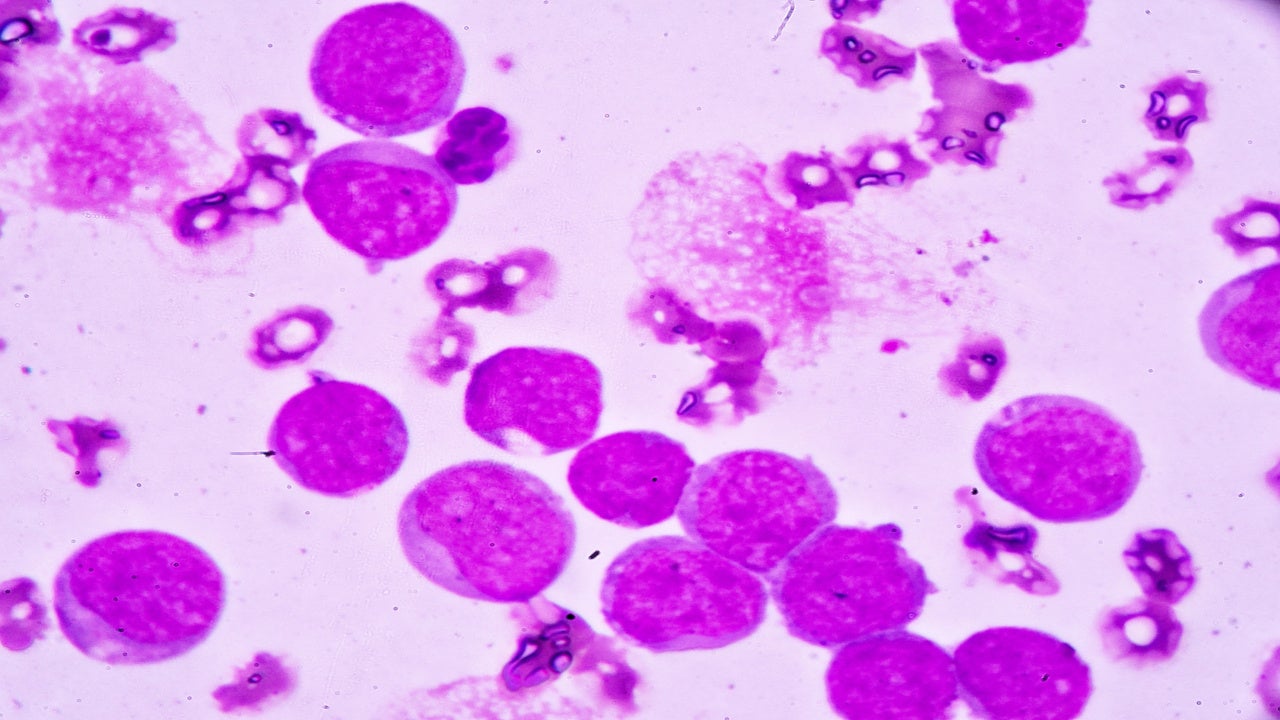
- No new safety concerns coming out of Phase Ib trial desired to move forward
- Moving to Phase II, triplet needs to show superiority over rival
- Targeting specific mutations important for clinical utility
Argenx’s cusatuzumab, as part of a triplet regimen, draws mixed expert perspectives on its potential safety profile in a Phase Ib study in previously untreated acute myeloid leukaemia (AML). While some said there should be no increase in the primary adverse events outcome to be considered a positive trial, others noted there is always a safety risk when adding new agents to standard treatment regimens. That said, cusatuzumab’s mechanism could negate potential safety concerns, some experts said.
Cusatuzumab, an anti-CD70 monoclonal antibody, is being evaluated on top of background therapy of Bristol Myers Squibb‘s Vidaza (azacitidine) and AbbVie and Roche’s Venclyxto (venetoclax) in the Phase Ib ELEVATE trial in newly diagnosed, elderly patients with AML who are ineligible for intensive chemotherapy. Another arm is assessing cusatuzumab with Venclyxto alone.
Argenx will determine whether to initiate additional studies in the development of cusatuzumab, under a collaboration with, following data review of ELEVATE, according to an 8 January corporate presentation. The trial has a 30 June completion date.
If no new safety events occur in the Phase Ib, the next stage of trial results would need to demonstrate significantly improved efficacy or a more attractive safety profile before physicians consider the triplet’s use in clinic, said experts. There is the potential in future studies to target subgroups that do not respond as well to current treatment, they said. Still, displacing standard of care (SOC) would be difficult unless significant superiority is shown, due to physicians’ familiarity with the existing SOC doublet, they added.
Cusatuzumab is also being trailed in the Phase II CULMINATE trial, in combination with Vidaza in newly diagnosed patients 18 and older ineligible for chemotherapy. Interim results released on 8 January indicated lower efficacy benchmarks reached than an earlier Phase I/II study. On 2 December 2018, Argenx announced a licensing agreement with Johnson & Johnson worth $300m in an upfront payment and $200m in share purchases to develop cusatuzumab in AML, myelodysplastic syndromes (MDS) and other haematological malignancies, according to a company media release. Argenx, which has a market cap of $15.29bn, did not respond to a request for comment.
How well do you really know your competitors?
Access the most comprehensive Company Profiles on the market, powered by GlobalData. Save hours of research. Gain competitive edge.

Thank you!
Your download email will arrive shortly
Not ready to buy yet? Download a free sample
We are confident about the unique quality of our Company Profiles. However, we want you to make the most beneficial decision for your business, so we offer a free sample that you can download by submitting the below form
By GlobalDataExperts mixed on safety prospects
The primary endpoint of ELEVATE is frequency and severity of adverse events (AEs) up to 32 months. Safety issues with the Vidaza and Venclyxto doublet, the current SOC for newly diagnosed AML patients who do not qualify for chemotherapy, include prolonged myelosuppression, neutropenia, cytopenia and pneumonia, said Dr Eunice Wang, chief of leukaemia services, Roswell Park Comprehensive Cancer Centre, Buffalo, New York. Seeing effective administration without prolonged neutropenia, an increase in myelosuppression or death would bode well for the combination, said Dr Daniel DeAngelo, professor, Dana-Farber Cancer Institute, Boston, Massachusetts. Any increase in myelosuppression would be a big concern for the triplet, DeAngelo and Wang added.
There is always a risk of increasing toxicity when adding agents to a regimen, said Håkon Reikvam, professor, Department of Clinical Science, University of Bergen, Norway. Any severe infections or bleeding are a concern with AML patients because of their weakened immune systems, said Reikvam. Quality of life is also very important and any gastrointestinal side effects, such as diarrhoea and vomiting, would be unwelcome in this patient group, he added. Wang agreed that there is always a risk when adding more agents but noted that any infusion-related reaction would be manageable. In addition, cusatuzumab’s mechanism as an early-administered anti-CD70 antibody makes it a good candidate to combine with the SOC and may result in no new AEs, said Wang and DeAngelo. Venclyxto is a BH3-mimetic that blocks the anti-apoptotic B-cell lymphoma-2 (Bcl-2) protein, as per AbbVie’s website, while Vidaza works by inhibiting the DNA methyltransferase protein, according to the FDA. In the Phase II CULMINATE trial, interim results showed that cusatuzumab in combination with Vidaza was well-tolerated, with a safety profile consistent with prior studies, according to an 8 January company media release.
In future trials, if the triplet could eventually reduce the level of Venclyxto, most associated with myelosuppression, and demonstrate a similar efficacy to the SOC then it would bode well for use in clinics, said DeAngelo. Only if the triplet resulted in higher responses rates than the current SOC but a worse safety profile, would Wang then consider lowering the level of Venclyxto to reduce myelosuppression.
Activity crucial to challenge SOC
Looking forward to a Phase II trial to assess efficacy, Argenx’s proposed triplet would have to show a superior efficacy to the SOC to garner physician attention, said experts. The doublet of Vidaza and Venclyxto has shown composite complete remission (CR and CRi) rates of 66.4% and overall survival (OS) of 34% in AML patients 75 and older or those with comorbidities in AbbVie’s Phase III VIALE-A trial. For DeAngelo, the CR would need to be higher than 70% to pose a real threat to the SOC, with no new AEs occurring. It would at least need to match the CR of 66%, if not exceed it, added Wang. In the Phase II CULMINATE trial, interim results showed that in 52 patients receiving 20mg/kg of cusatuzumab in combination with Vidaza, there was a CR rate of just 27%, far lower than the 66% reported in its Phase I/II trial of 12 patients.
In terms of changing clinical practice, the general rule of thumb for changing treatments is a CR 10% higher than current therapies, with a similar safety profile, said Reikvam. He is, however, more focused on OS than CR, viewing OS as far more important for patients, with CR acting as only a surrogate. Either an improvement of 10% or more in CR or extending OS by three months, to 15–18 months, would make it an easy choice to switch, said DeAngelo. Wang agreed and said the triplet would need to display equal efficacy to the SOC or an extra benefit in terms of safety or administration to justify the addition of another agent to treatment.
It would be highly unlikely that any regulator would approve the triplet based on a similar CR or OS, so it would need to show superiority, said Dr Mark Levis, PhD, professor of oncology at Johns Hopkins Sidney Kimmel Comprehensive Cancer Centre. A greater proportion of CRs, instead of remissions with incomplete blood count recovery, would be welcome and improve approval prospects over competitors, he said.
Targeting mutations underserved by current treatments
A different space for cusatuzumab’s utilisation is to focus in the future on those mutational subgroups in AML that do not respond as well to the current SOC, said DeAngelo and Levis. Currently, those patients with TP53 and FLT3-ITD mutations do not respond as well to Vidaza and Venclyxto and are associated with worse CR and OS rates than those who do not have the mutation, experts explained.
Lumping subgroups together in trials as done in this current Phase Ib, however, produces variegated responses between patients and, when collated, blurs understanding of who the treatment is best suited for, Levis said. The FDA is cognizant that patients with these mutations are less receptive to current therapies, so targeting them in future trials through subgroup analysis could be one strategy for approval, said DeAngelo.
Having said that, Vidaza and Venclyxto is still SOC in those patients, said DeAngelo. Even if a new triplet did show an improved efficacy in certain mutations, it would have a hard time displacing the SOC due to physicians’ familiarity with the doublet, experts agreed.
Sean Rai-Roche is a Reporter for Clinical Trials Arena parent company GlobalData’s investigative journalism team. A version of this article originally appeared on the Insights module of GlobalData’s Pharmaceutical Intelligence Center. To access more articles like this, visit GlobalData.









Related Company Profiles
Johnson & Johnson
AbbVie Inc
Bristol-Myers Squibb Co
Argenx SE